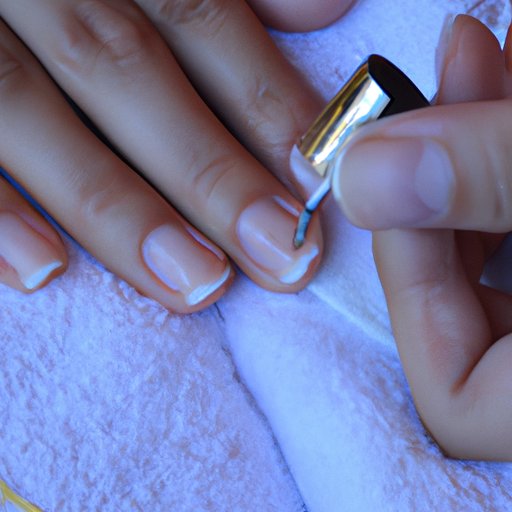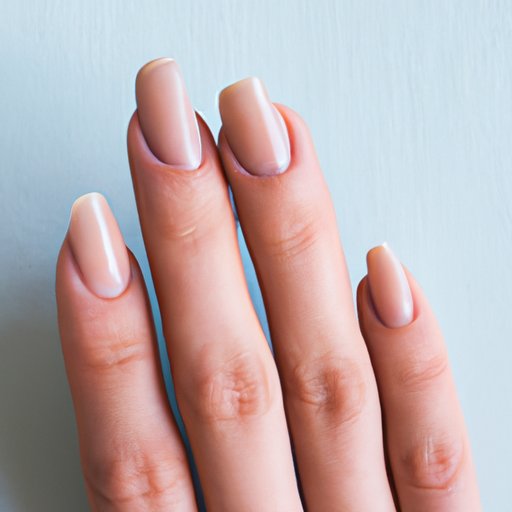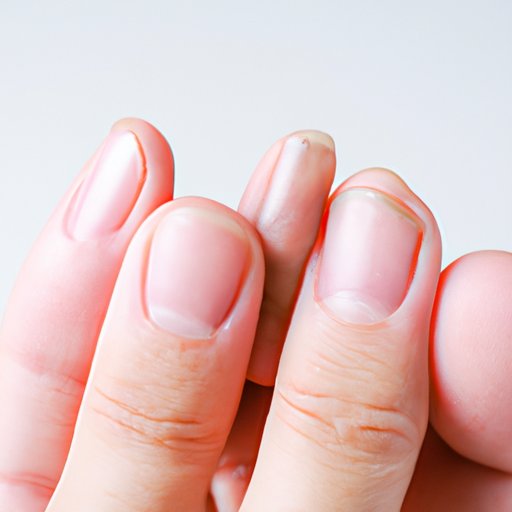Introduction
Having healthy fingernails is an important part of overall health and hygiene. But what exactly does a healthy fingernail look like? In this article, we’ll explore the definition of a healthy fingernail and provide an overview of common nail problems and reasons for unhealthy nails. We’ll also discuss how to tell if your nails are healthy and provide tips for keeping a healthy set of nails. Additionally, we’ll offer a guide to recognizing the signs of unhealthy nails and how to fix them. Finally, we’ll discuss the importance of proper nail care and understanding the anatomy of a healthy fingernail.
Definition of Healthy Fingernail
A healthy fingernail is one that is strong, smooth, and free from any type of discoloration or deformity. Healthy nails should have an even color, no ridges or pits, and a glossy sheen. They should be flexible and free from any signs of infection or damage. Healthy nails should also have a normal shape, with all the edges and corners intact. The cuticles should be intact and smooth, and there should be no white spots or other visible signs of damage.
Overview of Common Nail Problems and Reasons for Unhealthy Nails
There are several common nail problems that can lead to unhealthy nails. These include fungal infections, ingrown toenails, dryness or peeling, injury or trauma, and other forms of damage. Other causes of unhealthy nails include poor nutrition, excessive exposure to chemicals, and lack of proper hygiene. Poor nail care can also lead to unhealthy nails.

How to Tell if Your Nails are Healthy
The best way to tell if your nails are healthy is to look at their color, shape, and texture. If your nails are yellow, brittle, or otherwise discolored, they may not be healthy. Healthy nails should also be relatively smooth and uniform in shape. If there are any pits, ridges, or other deformities, this could indicate an underlying health condition.
It’s also important to check for signs of infection. Look for any redness, swelling, or discharge around the nails. These could all be indicative of a bacterial or fungal infection. Additionally, examine your cuticles to make sure they are intact and free from any signs of irritation or redness.

Tips for Keeping a Healthy Set of Nails
Eating a balanced diet is key to maintaining healthy nails. Make sure you’re getting enough protein, vitamins, and minerals to keep your nails strong and resilient. Additionally, avoid exposing your nails to harsh chemicals. Wear gloves when cleaning or working with chemicals to protect your nails from harm.
Practicing proper hygiene is also important for keeping your nails healthy. Use a mild soap and warm water to wash your hands and nails regularly. Avoid using harsh soaps or detergents as these could strip away natural oils from the nails. Additionally, moisturize your nails and cuticles daily to prevent dryness and cracking.
Finally, wear gloves whenever necessary to protect your nails from injury or trauma. This is especially important when gardening or doing chores around the house. Wearing gloves can help keep your nails safe and reduce the risk of developing any type of infection.
A Guide to Recognizing the Signs of Unhealthy Nails
When it comes to recognizing the signs of unhealthy nails, there are several things to look out for. Discoloration is one of the most common signs of unhealthy nails. Yellow, green, or brown discoloration could all be indicative of an underlying health issue. Pitting or ridges in the nails could also be a sign of an underlying problem, as could brittle or cracked nails.
Deformity or abnormal length can also be indicative of an unhealthy nail. White spots or streaks on the nails could also be a sign of a mineral deficiency or other health issue. If you notice any of these signs, it’s important to see a doctor to determine the cause.
Common Nail Problems and How to Fix Them
Fungal infections are one of the most common nail problems. These infections are caused by fungus that thrives in warm, moist environments. The best way to treat a fungal infection is to use an antifungal medication prescribed by your doctor. Additionally, keeping your nails clean and dry can help prevent further infection.
Ingrown toenails are another common problem. To prevent and treat ingrown toenails, make sure you’re wearing properly fitting shoes and trimming your toenails regularly. If you’re experiencing pain or discomfort, see a doctor for treatment.
Dryness or peeling of the nails can be caused by a number of factors, including lack of moisture or exposure to harsh chemicals. To prevent and treat dryness, use a moisturizer specifically designed for nails and cuticles. Additionally, try to limit your exposure to chemicals and wear gloves whenever possible.
Finally, injury or trauma to the nails can lead to unhealthy nails. To prevent injury, make sure to wear protective gloves when necessary. If you experience any trauma to the nails, seek medical attention immediately.

The Importance of Proper Nail Care
Proper nail care is essential for maintaining healthy nails. Healthy nails can help you look and feel your best. Additionally, keeping your nails healthy can help protect against infection and other health issues. On the other hand, unhealthy nails can lead to pain, infection, and other problems.
Understanding the Anatomy of a Healthy Fingernail
In order to properly care for your nails, it’s important to understand the anatomy of a healthy fingernail. The nail plate is the hard outer layer of the nail. It is made up of keratin cells and helps protect the nail bed. The nail bed is the fleshy area beneath the nail plate. It contains blood vessels and nerves and helps nourish the nail plate.
The cuticle is the thin layer of skin that surrounds the base of the nail. It helps protect the nail from bacteria and other contaminants. The nail fold is the skin that encircles the nail plate. It helps keep the nail plate in place and provides additional protection.

Nail Health: What to Look Out For
When it comes to nail health, it’s important to recognize the signs of poor health. Look out for yellow, brittle, or discolored nails. Additionally, watch for pits, ridges, or other deformities in the nails. If you notice any of these signs, it’s important to see a doctor to determine the cause.
Prevention and treatment are the best ways to maintain healthy nails. Eat a balanced diet, avoid exposing your nails to harsh chemicals, practice proper hygiene, and wear gloves when necessary. Additionally, use moisturizers specifically designed for nails and cuticles to keep them hydrated and healthy.
Conclusion
In conclusion, healthy fingernails are an important part of overall health and hygiene. Healthy nails should be strong, smooth, and free from any type of discoloration or deformity. Common nail problems include fungal infections, ingrown toenails, dryness or peeling, and injury or trauma. In order to recognize the signs of unhealthy nails and keep them healthy, it’s important to understand the anatomy of a healthy fingernail and practice proper nail care. Eating a balanced diet, avoiding chemical exposure, practicing proper hygiene, and wearing gloves when necessary are all key to maintaining healthy nails.
(Note: Is this article not meeting your expectations? Do you have knowledge or insights to share? Unlock new opportunities and expand your reach by joining our authors team. Click Registration to join us and share your expertise with our readers.)
